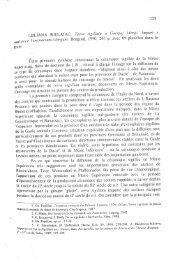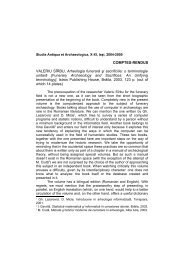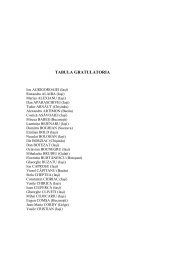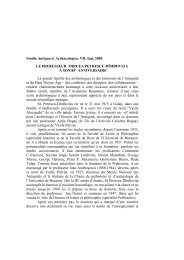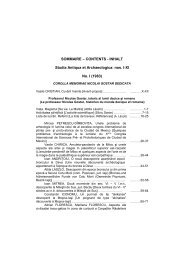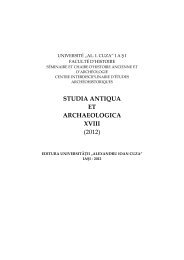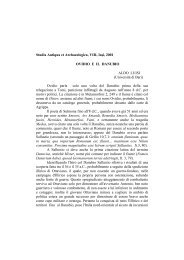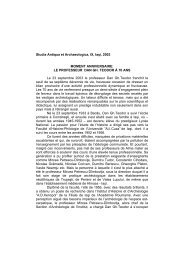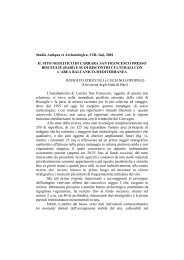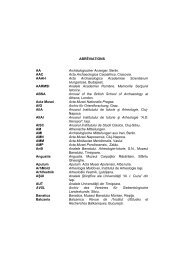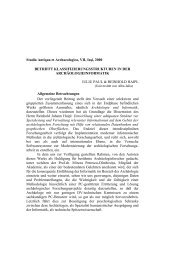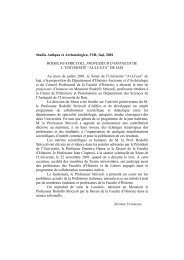IRENE PEKÁRY, Repertorium der hellenistischen und römischen ...
IRENE PEKÁRY, Repertorium der hellenistischen und römischen ...
IRENE PEKÁRY, Repertorium der hellenistischen und römischen ...
Create successful ePaper yourself
Turn your PDF publications into a flip-book with our unique Google optimized e-Paper software.
Studia Antiqua et Archaeologica, IX, Iaşi, 2003<br />
SECOND INTERNATIONAL CONGRESS ON BLACK SEA ANTIQUITIES:<br />
"LOCAL POPULATIONS OF THE BLACK SEA LITTORAL AND THEIR<br />
RELATIONS WITH THE GREEK, ROMAN AND BYZANTINE WORLDS AND<br />
NEAR EASTERN CIVILISATIONS", Bilkent University Ankara (Turkey),<br />
2-9 September 2001<br />
Octavian Bounegru<br />
After the fall of the Iron Curtain, the European archaeological community<br />
manifested a growing interest in the study of pontic area. Numerous and very<br />
special researches from this area, less known until that point (especially the ones<br />
from the former USSR), were not easily accessible to the specialists. There were<br />
some additional factors that have contributed to this situation: the customary<br />
practice of publishing the results in local languages (Russian, Bulgarian,<br />
Romanian, etc.), the absence of stabile relations between the specialists, and<br />
more than that the inexistence of common collaboration projects. After 1990, in<br />
Germany, France and England more and more scientifically, archaeological and<br />
historical groups had been fo<strong>und</strong>ed with the explicit purpose of researching the<br />
Greek-Roman Antiquity in the Black Sea region. Perhaps the most active proved<br />
to be the one led by a young scientist from London, Gocha Tsetskhladze who<br />
organized a remarkable publishing activity regarding the pontic studies. He is the<br />
chief editor of collective volumes and monographers (Colloquia Pontica) -15<br />
volumes have already been published, as well the editor of a papers called<br />
Ancient West and East.<br />
Gocha Tsetskhladze is also the organizer of a very important congress,<br />
INTERNATIONAL CONGRESS ON BLACK SEA ANTIQUITIES, which plays a<br />
special role in the consolidation of the relations between the researcher’s teams<br />
(historians, archaeologists, linguists, epigraphers) on the pontic problems, from<br />
the Greek Archaic period until Byzantine period. G.T. made a visit to Romania<br />
and launch an invitation to organize the first edition of the Congress in Constanţa<br />
(the ancient Tomis). Unfortunately, the organizer’s promises haven’t been<br />
respected, so the first Congress took place in September 1997, at Varna, in<br />
Bulgaria. Un<strong>der</strong> the scientifical coordination of J. Boardman, G.T. continued this<br />
important activity and organized, in September 2001, the Congress in Ankara.<br />
The theme was "Local Population of the Black Sea Littoral and their relations with<br />
the Greek, Roman and Byzantine Worlds and Near Eastern Civilisations". The<br />
Congress was organize by "Bilkent Universitesi" from Ankara in collaboration with<br />
the British Archaeological Institute.<br />
The interventions were grouped in several Sessions: 1. Anatolia and the<br />
Caucasus; 2. The North Black Sea Coast; 3. The West Black Sea Coast; 4.<br />
Ancient Persia; 5. Byzantium and its Black Sea Neighbours; 6. Varia. This<br />
thematic section covers the whole range from history and archaeology in the
541 Octavian Bounegru<br />
pontic regions, both from geographic and chronological point of view. Recent<br />
archaeological researches in the Black Sea area were presented (Angelika<br />
Geyer, Annegret Plontke-Lüning, Nadine Fellmuth - Friedrich-Schiller Üniversität,<br />
Jena: Apsaros als Zentrum <strong>der</strong> Akkulturation im Ostpontos (1.-7. Jh. n. Chr.;<br />
th<br />
Mikhail Treister - Moscow: 4 Century B.C. Gold work from the Hellespont and its<br />
Links with Precious Metalwork of the North Pontic Area), or regarding the<br />
relations between the Greeks and the barbarian world ( Andrei Yu. Alekseev<br />
(State Hermitage Museum, St. Petersburg) Greeks and Barbarians on the North<br />
Black Sea Coast; Askold Ivantchik (CNRS, France) Les problèmes actuels de la<br />
chronologie des cultures pré-scythe et scythe archaïque à la lumière des données<br />
proche-orientales). Three days were reserved for the posters Sessions.<br />
Scholars from Romania attended the Congress presenting both<br />
communications as well as posters (Coriolan Opreanu, Diplomacy and War.<br />
Relations between the Roman Empire and the Barbarians to the North of the<br />
Danube; Alexandru Avram, The Western Black Sea in Graeco-Roman Times;<br />
Octavian Bounegru, Der westliche Pontosraum <strong>und</strong> seine Handelsbeziehungen in<br />
<strong>der</strong> <strong>römischen</strong> Kaiserzeit); Livia Buzoianu, Représentations d'Aphrodite dans la<br />
cité d'époque hellénistique d'Albesti (département de Constantza); Zaharia<br />
Covacef, Capidava - wichtiges römisch-byzantinisches Zentrum auf dem Donaulimes;<br />
Gabriel-Gheorghe Custurea, Byzantine Coins Penetration in Dobroudja in<br />
the 7th-10th Century).<br />
The ancient monuments from Ankara and Gordion were visited, as well<br />
as the Museum of Anatolian Civilisations from Ankara. In the last two days of the<br />
Congress two excursions were organized, optionally: The Black Sea Coast (Sinop<br />
and Samsun) or Central Anatolia. The organization was beyond reproach thanks<br />
to our Turkish and British colleagues. The high quality of the interventions is to be<br />
mentioned here, as well as the numerous historical and archaeological<br />
information’s provided. At the closing Session, the University of Prague was<br />
nominated as the future organizer of the next Congress.




